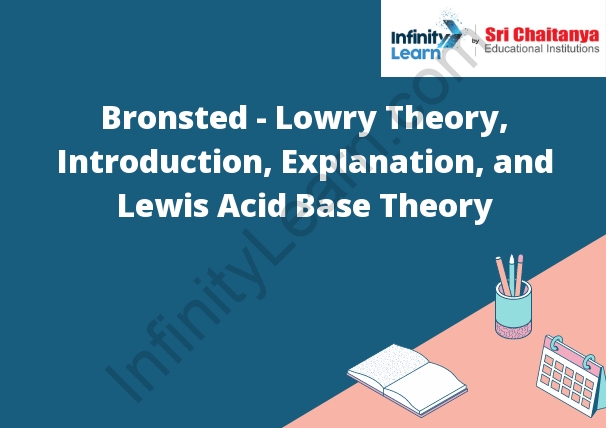Table of Contents
What is Bronsted – Lowry Theory?
The Bronsted-Lowry theory of acids and bases is a model that describes acids and bases in terms of their proton (H+) donors and acceptors. According to this theory, an acid is a proton donor, and a base is a proton acceptor.
This theory is based on the following definition of an acid:
- An acid is a substance that donates a proton (H+) to another substance.
- This definition is based on the following definition of a base:
- A base is a substance that accepts a proton (H+) from another substance.

Bronsted – Lowry Theory – Introduction
- In 1923, Danish chemist Johannes Nicolaus Bronsted and English chemist Thomas Martin Lowry independently proposed a theory to explain the behavior of acids and bases. Bronsted and Lowry’s theory, which is now known as the Bronsted-Lowry theory, states that acids are proton donors and bases are proton acceptors.
- According to the Bronsted-Lowry theory, an acid is a substance that donates a proton (H+) to a base. A base is a substance that accepts a proton from an acid. When an acid and a base interact, the acid donates a proton to the base, and the base accepts the proton. This interaction results in the formation of a new molecule, called a salt.
- The Bronsted-Lowry theory is based on the idea that acids and bases are substances that can exchange protons. In other words, an acid can donate a proton to a base, and a base can accept a proton from an acid. This exchange of protons results in the formation of a new molecule, called a salt.
- The Bronsted-Lowry theory is important because it explains the behavior of acids and bases. It also explains why acids and bases react with each other to form salts.
Explanation
In 1923, Danish chemist Johannes Nicolaus Bronsted and English chemist Thomas Martin Lowry independently proposed a theory to explain the behavior of acids and bases. This theory, which is now referred to as the Bronsted – Lowry theory, states that acids are proton donors and bases are proton acceptors.
According to the Bronsted – Lowry theory, an acid is a molecule that can donate a proton (H+) to a base. A base is a molecule that can accept a proton from an acid. When an acid and a base interact, the acid donates a proton to the base, and the base accepts the proton. This process results in the formation of a new molecule, which is called a salt.
The Bronsted – Lowry theory has been very successful in explaining the behavior of acids and bases. It has also been used to develop a number of theories that explain the behavior of chemical reactions.
Definitions of Acids and Bases
An acid is a molecule or ion capable of donating a proton (H+) to another molecule or ion.A base is a molecule or ion capable of accepting a proton (H+) from another molecule or ion. Acids and bases have been around for centuries, but their definitions have not always been the same. The modern definition of an acid is a molecule that donates a proton to a base. A base is a molecule that accepts a proton from an acid. The most common definition of an acid is a molecule that dissociates in water to produce a hydrogen ion and a hydroxide ion. Bases are molecules that dissociate in water to produce a hydroxide ion and a positive ion.
Aqueous Solutions
Aqueous solutions are solutions in which water is the solvent. Water is a polar molecule and is able to dissolve many ionic compounds. This is due to the polar nature of water molecules and the fact that water molecules are able to form hydrogen bonds with each other and with other polar molecules.
Comparison with Lewis Acid-Base Theory
The Bronsted-Lowry acid-base theory is similar to the Lewis acid-base theory in that both theories involve the transfer of a proton. The Bronsted-Lowry theory, however, is based on the idea that an acid is a proton donor and a base is a proton acceptor. The Lewis acid-base theory is based on the idea that an acid is a electron-pair acceptor and a base is an electron-pair donor.
Lewis Acid Base Theory
- In chemistry, acids and bases are two types of molecules that can interact with each other. Acids are molecules that release protons (hydrogen ions) in water, while bases are molecules that accept protons. The proton is the nucleus of the hydrogen atom, which is why acids are often referred to as “hydrogen acids.”
- The acid base theory is a model that helps chemists understand how these molecules interact with each other. The theory states that acids and bases are two ends of a spectrum, with water occupying the middle. Acids are molecules that are willing to give up protons, while bases are molecules that are willing to accept them.
- The acid base theory is important because it helps chemists understand how molecules interact with each other. It also helps chemists understand the behavior of acids and bases in solutions.





